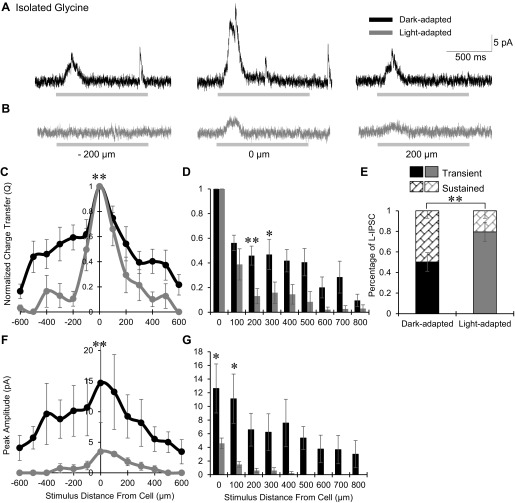Fig. 5.
Light adaptation narrows the isolated glycinergic spatial inhibitory input to OFF bipolar cells. A and B: example glycinergic L-IPSCs recorded from an OFF type 1/2 bipolar cell in dark- and light-adapted conditions (CW = 67, CM = 0.971), black and gray traces, respectively, (1-s flash of a 25-μm bar of light, −200, 0, and 200 μm away from the recorded cell). Light adaptation significantly reduced L-IPSCs 200 μm away from the OFF bipolar cell and decreased the center L-IPSC. Light stimulus is indicated by gray bars under L-IPSCs; OFF type 1/2 bipolar cells respond at the onset of light. C: spatial inhibition curves of glycinergic Q, normalized to the center bar stimulus, in dark (n = 10)- and light (n = 4)-adapted conditions. The spatial inhibitory distribution became significantly narrower with light adaptation. D: glycinergic L-IPSC Q, normalized to the center L-IPSC, compared between dark (0–300 μm, n = 20; 400–800 μm, n = 10)- and light (0–300 μm, n = 9; 400–800 μm, n = 4)-adapted conditions at each stimulus distance. The proportion of inhibition was significantly smaller at multiple locations with little to no inhibition remaining after 500 μm away from the recorded cell. E: the average proportion of center glycinergic L-IPSC response that is transient or sustained in dark- and light-adapted conditions (n = 9). L-IPSCs became significantly more transient with light adaptation. F: spatial inhibition curves of glycinergic peak amplitude in the dark- and light-adapted conditions. The peak amplitude distribution was significantly narrower and smaller with light adaptation. G: glycinergic L-IPSC peak amplitude compared between dark- and light-adapted conditions at each stimulus distance. The proportion of inhibition was significantly smaller under light adaptation at multiple locations with no inhibition beginning at 500 μm away from the recorded cell. *P < 0.05; **P < 0.01.

